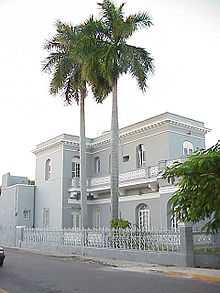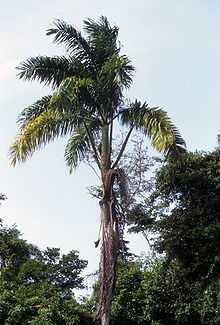Roystonea dunlapiana
| Roystonea dunlapiana | |
|---|---|
 | |
| Roystonea dunlapiana | |
| Conservation status | |
| Scientific classification | |
| Kingdom: | Plantae |
| (unranked): | Angiosperms |
| (unranked): | Monocots |
| (unranked): | Commelinids |
| Order: | Arecales |
| Family: | Arecaceae |
| Genus: | Roystonea |
| Species: | R. dunlapiana |
| Binomial name | |
| Roystonea dunlapiana P.H.Allen | |
Roystonea dunlapiana, commonly known as yagua or cabiche is a species of palm which is native to southern Mexico and Central America. It is the only species in the genus Roystonea which is absent from the insular Caribbean.
Description
Roystonea dunlapiana is a large palm which reaches heights of 20 metres (66 ft). Stems are grey-white and about 38 centimetres (15 in) in diameter. The upper portion of the stem is encircled by leaf sheaths, forming a green portion known as the crownshaft which is about 2 m (6.6 ft) long. Individuals have about 15 leaves with 4-metre (13 ft) rachises; the leaves hang well horizontal. The 1 m (3.3 ft) inflorescences bear white male flowers with purplish anthers; the female flowers are undescribed. Fruit are 12–14.7 millimetres (0.47–0.58 in) long and 7.1–9.5 mm (0.28–0.37 in) wide, and are purplish black when ripe.[1]
Taxonomy
Roystonea is placed in the subfamily Arecoideae and the tribe Roystoneae.[2] The placement Roystonea within the Arecoideae is uncertain; a phylogeny based on plastid DNA failed to resolve the position of the genus within the Arecoideae.[3] As of 2008, there appear to be no molecular phylogenetic studies of Roystonea[2] and the relationship between R. dunlapiana and the rest of the genus is uncertain.
The species was first described by American botanist Paul H. Allen in 1952. Allen's description of R. dunlapiana, together with his description of R. regia var. hondurensis (now synonymised with typical R. regia) was the first record of Roystonea species native to Central America.[1]
Common names
The species is commonly known as yagua or cabiche in Honduras.[1]
Distribution

References
- ↑ 1.0 1.1 1.2 1.3 Zona, Scott (December 1996). "Roystonea (Arecaceae: Arecoideae)". Flora Neotropica 71: 1–35.
- ↑ 2.0 2.1 Roncal, Julissa; Scott Zona; Carl E. Lewis (2008). "Molecular Phylogenetic Studies of Caribbean Palms (Arecaceae) and Their Relationships to Biogeography and Conservation". The Botanical Review 74 (1): 78–102. doi:10.1007/s12229-008-9005-9.
- ↑ Asmussen, Conny B.; John Dransfield; Vinnie Deickmann; Anders S. Barfod; Jean-Christophe Pintaud; William J. Baker (2006). "A new subfamily classification of the palm family (Arecaceae): evidence from plastid DNA phylogeny". Botanical Journal of the Linnean Society 151 (1): 15–38. doi:10.1111/j.1095-8339.2006.00521.x.
